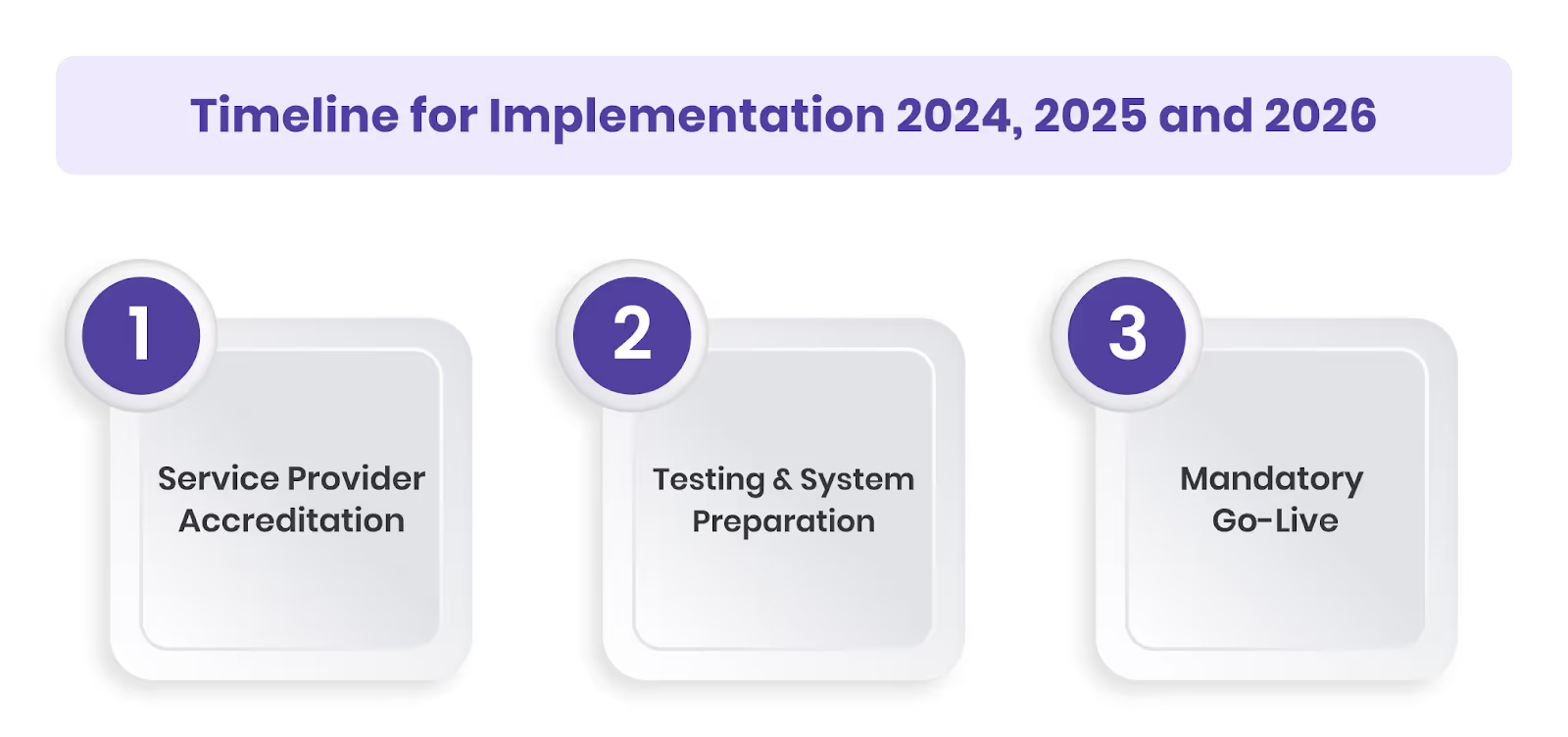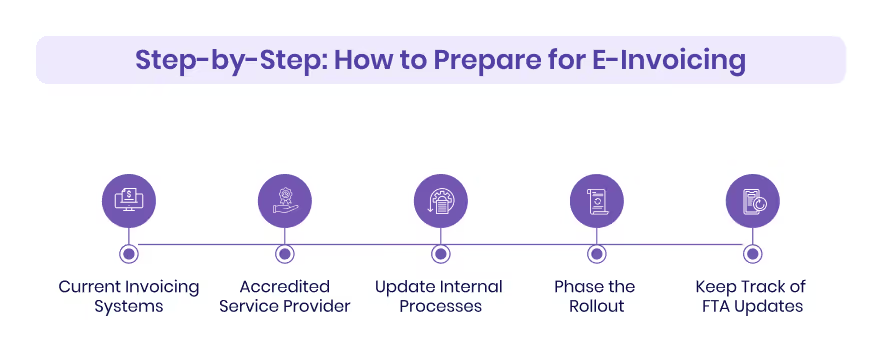E-invoicing in the UAE is no longer a distant plan — it’s happening now. With the Federal Tax Authority (FTA) and Ministry of Finance (MoF) rolling out the mandate in phases, every VAT-registered business needs to take a closer look at its invoicing systems. By July 2026, electronic invoicing will be mandatory for B2B and B2G transactions, and companies that fail to comply risk fines, rejected invoices, and disrupted cash flows.
But compliance isn’t just about avoiding penalties. It’s about protecting your ability to recover VAT, staying aligned with the UAE’s digital economy strategy, and ensuring your business remains trusted by customers, partners, and regulators.
In this blog, we’ll break down the legal foundation of the e-invoicing mandate, the rollout timeline, the scope of transactions covered, and the penalties for non-compliance. We’ll also share how forward-thinking businesses are using this transition to strengthen their finance operations — rather than seeing it as just another box to tick.
This article was last updated on 26 August 2025 to reflect the latest MoF and FTA guidelines.
The Legal Foundation of UAE E-Invoicing
The framework for e-invoicing in the UAE is built on recent amendments to the VAT law and supporting Cabinet decisions. These provide the legal backbone for the transition.
- Federal Decree-Law No. 16 of 2024 amended the VAT law to formally recognize electronic invoices as valid tax documents. This law came into effect on 1 November 2024, setting the stage for mandatory adoption.
- Cabinet Decision No. 49 of 2021 remains relevant because it defines penalties for VAT invoice failures — rules that now extend to electronic invoicing.
- Oversight and enforcement lie with the Ministry of Finance (MoF) and the Federal Tax Authority (FTA), which publish official guidelines, FAQs, and updates.
Together, these rules confirm that e-invoicing is not optional. From 2026, issuing paper invoices for B2B or B2G transactions will simply not be compliant.
Official references: Federal Tax Authority, Ministry of Finance
Timeline for Implementation (2024–2026)


The UAE is taking a phased approach to e-invoicing, allowing businesses time to adapt their systems. As of August 2025, here’s how the rollout stands:
1. 2024: Legal Recognition and Service Provider Accreditation
- In November 2024, Federal Decree-Law No. 16 of 2024 came into effect, legally recognizing electronic invoices.
- The Ministry of Finance also began the service provider accreditation process, approving Authorized Service Providers (ASPs) who will enable businesses to generate and transmit compliant invoices.
2. 2025: Testing, Guidance, and System Preparation
- 2025 has been about legislative refinements and system setup. The MoF has issued criteria for ASPs and technical guidelines for businesses.
- Many early adopters have started testing their integrations with accredited providers to ensure smooth reporting.
- Businesses that begin compliance preparations now will avoid last-minute disruptions in 2026.
3. 2026: Mandatory Go-Live
- July 2026 is the enforcement milestone. From this date, all B2B and B2G invoices must be issued electronically.
- The rollout may be staggered: larger businesses are expected to comply first, followed by SMEs based on turnover thresholds.
- Non-compliance after this point will trigger penalties and, in some cases, invalidate invoices for VAT purposes.
Staying aligned with these milestones is critical. Businesses that act early can spread out costs, test systems gradually, and train staff before e-invoicing becomes mandatory.
Scope of UAE E-Invoicing: Businesses Required vs. Exempt
Not every transaction in the UAE will immediately fall under the e-invoicing mandate. The government has defined the scope of the rollout clearly, starting with the most relevant categories.
1. In-Scope Transactions
- Business-to-Business (B2B): All VAT-registered companies issuing invoices to other businesses must eventually switch to electronic invoicing.
- Business-to-Government (B2G): Companies dealing with government entities must also comply, ensuring invoices are digitally issued and reported.
These transactions are prioritized because they have the highest tax compliance impact.
2. Out-of-Scope (for Now)
- Business-to-Consumer (B2C): Retailers and service providers can continue issuing paper receipts to end consumers. However, the government has signaled that B2C digital invoicing may be considered in the future.
3. All VAT-Registered Businesses Must Comply
Even if your company is part of a VAT group, each member must comply individually, using an accredited service provider to issue and report invoices under the group’s TRN (Tax Registration Number). This ensures full traceability of transactions.
4. Possible Exemptions and Special Cases
While the FTA has not yet published a comprehensive exemption list, certain categories may receive special treatment. These could include:
- Free zone entities, where local rules apply differently.
- Small businesses with turnover below specific thresholds (phased in later).
- Sector-specific cases, depending on how regulations evolve.
Practical takeaway: Unless an exemption is officially confirmed, businesses should plan as if compliance is mandatory. It’s safer to prepare early than risk disruption.
Penalties for Non-Compliance
The UAE government has made it clear: ignoring e-invoicing rules will come at a cost. Businesses that fail to comply may face financial penalties, reputational risks, and operational setbacks.
1. Financial Fines
Under the existing VAT penalty regime (Cabinet Decision No. 49 of 2021), businesses face significant fines that will also apply in the e-invoicing era:
- Failure to issue a tax invoice: AED 2,500 for the first instance, AED 5,000 for repeat violations.
- Failure to maintain proper records: AED 10,000 for the first offense, doubling to AED 20,000 for repeat cases.
- Incorrect reporting or failure to transmit invoices via ASPs: Penalties will mirror existing VAT non-compliance fines, with further clarification expected from the FTA in 2025.
(Source: FTA Administrative Penalties Guide)
These amounts may sound modest, but they can quickly add up across multiple transactions.
2. Invalid Invoices and VAT Risk
Perhaps more serious than fines is the risk that non-compliant invoices may not be accepted for VAT credit claims. If your invoice is rejected by the system or not properly transmitted, your customer cannot recover input VAT — a situation that could strain business relationships and cash flow.
3. Real-Time Monitoring
The Federal Tax Authority (FTA) has the authority to monitor compliance through accredited service providers. Because invoices will be reported digitally in near real-time, gaps or errors are far easier to detect than with paper-based systems.
The message is simple: penalties go beyond fines. Non-compliance could disrupt operations and undermine financial trust. Preparing ahead of the July 2026 deadline is far less costly than dealing with penalties and disputes later.
Pro tip: Automating compliance with the right spend management tools (like those we explore on Alaan’s blog) can reduce these risks and give finance teams peace of mind.
How the UAE’s E-Invoicing Framework Compares Globally
The UAE is not alone in adopting e-invoicing. Around the world, governments are moving toward digital tax reporting to close VAT gaps and improve compliance. Comparing the UAE’s framework to other regions helps businesses understand what to expect.
1. Learning from Saudi Arabia
Saudi Arabia was the first in the Gulf to mandate e-invoicing, starting in December 2021 with a two-phase rollout managed by the Zakat, Tax and Customs Authority (ZATCA).
- Phase 1: Businesses had to generate invoices electronically and store them in a compliant format.
- Phase 2: Invoices were required to be reported to ZATCA in near real-time.
The UAE has drawn from this playbook but opted for a decentralized model using the Peppol PINT standard, avoiding the need for all invoices to pass through a central clearing system.
2. Europe’s Peppol Model
In Europe, countries like Italy, France, and Poland have rolled out e-invoicing systems tied to the Peppol network. This ensures interoperability across borders and standardization of invoice formats. The UAE’s choice to align with Peppol PINT shows a desire for international compatibility, which is particularly important given the country’s role as a global trade hub.
3. Asia-Pacific Developments
In Asia, countries such as India introduced e-invoicing for businesses above a certain turnover threshold. This staggered approach — starting with large companies and gradually lowering thresholds — is similar to what is expected in the UAE from 2026 onward.
4. The UAE’s Strategic Advantage
By blending global best practices with a business-friendly phased rollout, the UAE aims to:
- Ensure smooth adoption without disrupting trade.
- Reduce VAT evasion and increase transparency.
- Position itself as a regional leader in digital compliance.
For UAE companies operating internationally, this alignment also means fewer adjustments are needed when dealing with cross-border invoicing partners.
Related read: See how UAE finance leaders can use compliance changes as a catalyst for efficiency in our Alaan blog on digital finance.
Preparing Your Business for Compliance

With less than a year before e-invoicing goes live in July 2026, the most effective way for companies to minimize disruption is to start preparing now. Here’s how businesses can get ready:
1. Assess Your Current Invoicing Systems
- Review how invoices are currently created, stored, and shared.
- Identify gaps — for example, manual processes or legacy accounting systems that cannot generate structured electronic invoices.
[cta-9]
2. Choose an Accredited Service Provider (ASP)
- Only MoF-approved providers will be authorized to transmit compliant invoices.
- The accreditation process began in late 2024, and the official list is published on the MoF portal.
- Businesses should compare ASPs for features like ERP integration, scalability, and support.
3. Train Staff and Update Internal Processes
- Finance teams need training on new invoice formats and compliance checks.
- Workflows may need to be adjusted to ensure invoices are generated electronically from the start rather than converted later.
4. Test Early and Phase the Rollout
- Pilot the system before it becomes mandatory to spot issues early.
- Larger organizations can roll out in phases — starting with one business unit or subsidiary before going company-wide.
5. Keep Track of FTA Updates
- Regulations may evolve in the lead-up to July 2026.
- Subscribe to the FTA’s e-invoicing updates and check for new Cabinet or Ministerial decisions that refine the rules.
Businesses that treat e-invoicing as part of their digital finance strategy, rather than a compliance burden, will be better placed to benefit. Streamlined invoicing can reduce errors, speed up collections, and strengthen vendor relationships.
How Alaan Can Help You Stay Compliant
While regulatory requirements may seem complex, the right tools can make compliance straightforward. Alaan is more than just a corporate card platform — it helps finance leaders automate spend management, streamline reporting, and prepare for regulatory changes like e-invoicing.
With Alaan, businesses can:
- Digitize expense tracking to align with future-ready reporting standards.
- Automate invoice collection and approvals, reducing manual errors that can cause compliance issues.
- Gain real-time visibility into company spending, ensuring that financial data is accurate and audit-ready.
- Integrate seamlessly with accounting systems, helping teams stay ahead of deadlines and regulatory updates.
[cta-6]
As the UAE moves toward mandatory e-invoicing in 2026, having a modern spend management platform like Alaan ensures that compliance doesn’t slow your business down — instead, it becomes a driver of efficiency and control.
Learn more about how Alaan supports compliance and financial transformation on our Alaan blog.
Key Takeaways & Resources
The UAE’s e-invoicing mandate is one of the most significant regulatory shifts since VAT was introduced in 2018. With enforcement starting in July 2026, businesses have a clear — but limited — window to prepare.
Key Takeaways
- Legal foundation is in place: Federal Decree-Law No. 16 of 2024 legally recognized e-invoices, backed by Cabinet decisions and FTA guidance.
- Phased rollout: Accreditation of providers (2024), system preparation (2025), and mandatory go-live (2026).
- Scope of mandate: Applies first to B2B and B2G invoices; B2C receipts remain outside scope for now.
- Penalties are real: Non-compliance can lead to fines, invalid invoices, and denial of input VAT recovery.
- Proactive preparation is essential: Businesses should select an accredited provider, test systems early, and keep up with official updates.
Useful Resources
- Federal Tax Authority – E-Invoicing Portal
- UAE Ministry of Finance
- Alaan Blog on Business Spend Management (for practical insights on finance transformation and compliance readiness)
Conclusion
E-invoicing is no longer an abstract future regulation — it’s an imminent reality. Businesses that delay preparation may find themselves scrambling to catch up, risking financial penalties and operational setbacks. On the other hand, companies that act now can treat compliance as a step toward digital transformation, using automation and smarter systems to strengthen finance operations.
The next year is crucial. If your business hasn’t started yet, now is the time to assess your systems, choose a service provider, and train your teams. By July 2026, compliance won’t just be good practice — it will be the law.
At Alaan, we believe compliance should empower businesses, not slow them down. Our platform equips finance teams with the right tools to digitize processes, ensure accuracy, and stay one step ahead of evolving regulations like e-invoicing.
Ready to future-proof your finance function?
Book a demo with Alaan and see how our platform can help you stay compliant while empowering your teams with smarter spend management.
Frequently Asked Questions (FAQs)
1. Why is the UAE adopting e-invoicing?
The move aligns the UAE with global best practices and strengthens tax compliance. It reduces VAT fraud, improves transparency, and integrates UAE businesses into international trade systems by adopting Peppol PINT standards.
2. When will e-invoicing become mandatory in the UAE?
The rollout is phased:
- 2024: Service provider accreditation begins.
- 2025: Systems and ASP networks are set up, along with updated regulations.
- July 2026: E-invoicing becomes mandatory for B2B and B2G transactions for all VAT-registered businesses.
3. Which transactions are covered under the mandate?
Initially, the mandate covers Business-to-Business (B2B) and Business-to-Government (B2G) transactions. Business-to-Consumer (B2C) transactions are currently out of scope, though they may be included in future expansions.
4. Do free zone companies need to comply?
All VAT-registered entities — including those in free zones — are expected to comply, unless the FTA issues specific exemptions. Businesses should monitor updates closely, as sector-specific rules are expected in 2025.
5. What happens if a business does not comply with e-invoicing requirements?
Non-compliance can result in:
- Fines: AED 2,500 for the first violation of failing to issue a tax invoice, AED 5,000 for repeats.
- Invalid invoices: Non-compliant invoices may not qualify for VAT input recovery.
- Real-time detection: The FTA will be able to monitor non-compliance instantly through the digital system.
6. How should businesses prepare for e-invoicing?
Key steps include:
- Reviewing existing invoicing systems.
- Selecting a MoF-accredited ASP.
- Training finance teams.
- Staying updated with FTA announcements.
- Leveraging compliance to improve efficiency and cash flow


.avif)







